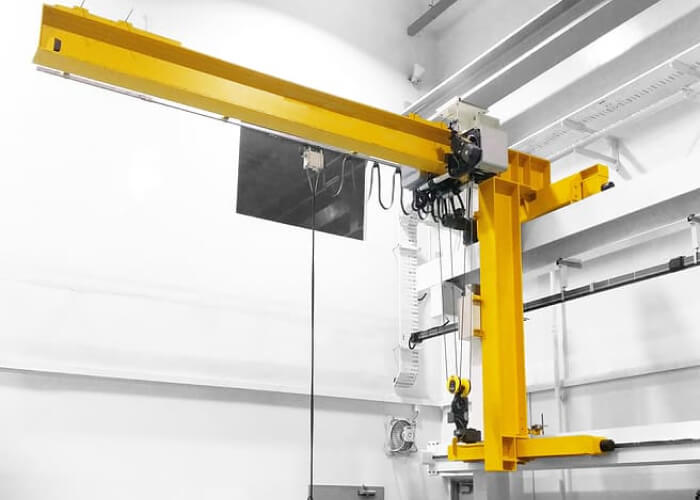How your factory can benefit from a swing jib crane
by Sumona How to Guides Published on: 30 November 2021 Last Updated on: 16 July 2024

There are various swing jib cranes that you can use in your factory. The type of jib crane that you purchase and use in your daily life will depend on our factory needs, your personnel, your budget, and your space. If you do not have extensive space inside of your factory, this can cause you to choose a smaller jib crane that is more portable. If you have more space, then choosing a stronger and more durable crane can be the best option.
Let’s look at the various jib cranes, which one is best for your factory needs, and WHY you should choose a jib crane to help you with your lifting and moving needs.
What is a swing jib crane?
First thing’s first – what is a swing jib crane? Simply put, a swing jib crane is a type of overhead crane that is usually used either as a floor-mounted open, wall-mounted choice, or roof-mounted option.
If you are considering using a lifting mechanism in your factory, then using the swing jib crane can be the best option to lift heavy objects, remain durable over long periods of time, and increase employee reliability in the machinery – instead of using dozens of people for manpower and smaller pieces of equipment, using the swing jib crane is more trustworthy.
But why? Well, the swing jib crane is not only easy to use, but it is durable, functional, and effective in all factory settings. You can either use the swing jib crane with manual rotation or an electrical power source – by providing you with the versatility of how to power the jib crane, you can ensure that your piece of equipment can be personally controlled to your standards (whether hydraulic-powered, manually powered, or electrically powered).
What are the different kinds of swing jib cranes that you can choose from?
When discussing the various types of jib cranes that you can use for your construction business or factory business, you need to know the different types. The most common type of crane that you can use to help move heavy objects and pick items up off of hit the floor is the swing jib crane. The swing jib crane can either be floor or wall cranes, typically being either freestanding or vertical.
Most of the time, swing jib cranes can be used in tandem with a smaller base plate that adds stability and durability to the jib crane. If you are using the jib sweden on a concrete or hard floor, then combining the swing jib crane with a base plate for more stability is key to avoiding any workplace accidents.
Keep in mind that if you use the wall-mounted swing jib crane for your factory, that these do not contain the vertical post, the base plate, or the compatibility to use with other machinery pieces. However, the best part about using the swing jib crane that is mounted on the wall is that they are bolted on the wall to add more strength and longevity – however, the agility and vetsialy of the swing jib crane is limited by the wall crane structure.
Are you considering using the swing jib crane to lift heavy materials? Then you have come to the right place! If you are thinking of using a jib crane to lift people to higher heights to provide more access to various levels of your factory or to work on machinery, then some jib cranes might not be ideal. However, swing jib cranes are a good idea for those who need to lift heavy pieces of equipment without using manpower or other pieces of machinery.
Swing jib crane types
To better understand what type of use in your new factory, you need to know the various types of swing jib cranes that can be used effectively for your factory needs. Do you need to pick up and put down heavy objects in a specific location? Do you need a more versatile choice? Find out the type of jib crane that will fit your factory and workplace requirements.
Column mounted free standing swing jib crane
As we discussed before, typically swing jib cranes are either manually powered or electrically powered – meaning they are rotated manually or electrically. The swing jib cranes that use manual rotation are typically the most popular option for businesses and factories, since they are less expensive – but remain very easy to use without needing mechanical experience.
For new business owners who are interested in upgrading the efficiency of their factory, manual swing jib cranes might be the best option – not to mention, they can still carry upwards of 2000 kg!
- The channel profile swing jib crane is one of the smallest options, coming in between 2 meters and 7 meters, but can lift upwards of 1000 kg.
- The “L” profile swing jib crane is between 2 meters and 5 meters and can lift anything from 63kg to 2000 kg.
- The over braced swing jib crane is ideal for lifting heavier weights that range from as light as 125kg to as high as 2000kg.
Wall-mounted swing jib cranes
One of the best types of swing jib cranes to use for factories is the wall-mounted jib crane, which is a good choice for those who need to maximize their floor space in a smaller-sized factory.
Non-standard swing ib Carne
Another type of swing jib crane that is very popular among factory owners is a non-standard swing jib crane – this type of swing jib crane is used for factories that need bespoke requirements and characteristics.
Conclusion
Are you considering using a swing jib crane for your factory? We don’t blame you! These durable types of lifting mechanisms are ideal for factories that need to lift heavy weights – even between 1000kg and 2000 kg! If you are debating what type of swing jib crane to purchase, consider looking at wall-mounted swing jib cranes, non-standard swing jib cranes, or column-mounted free-standing jib cranes. You can choose an option that is an overpriced design, underbraced, or moving arm design!
Read Also:







































































































